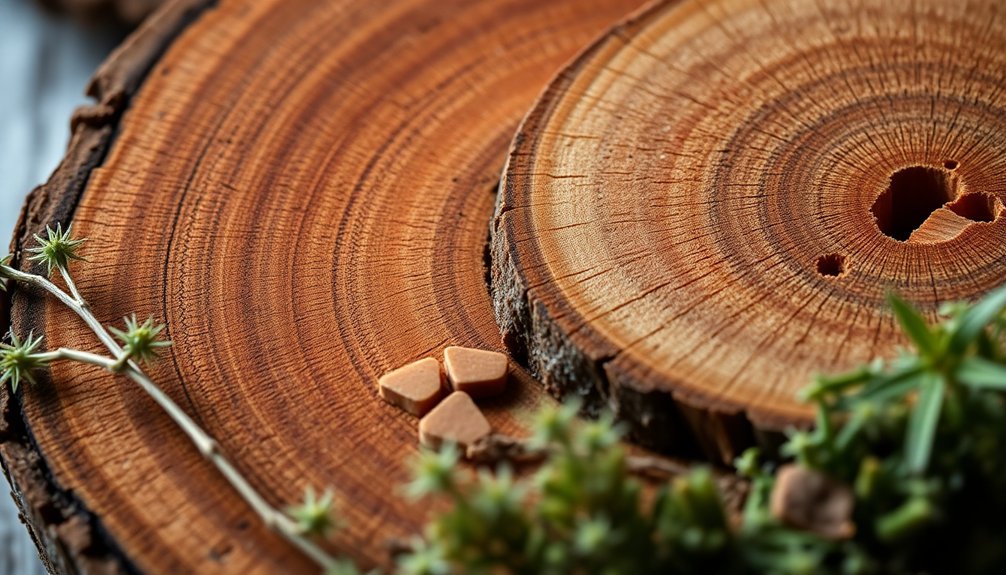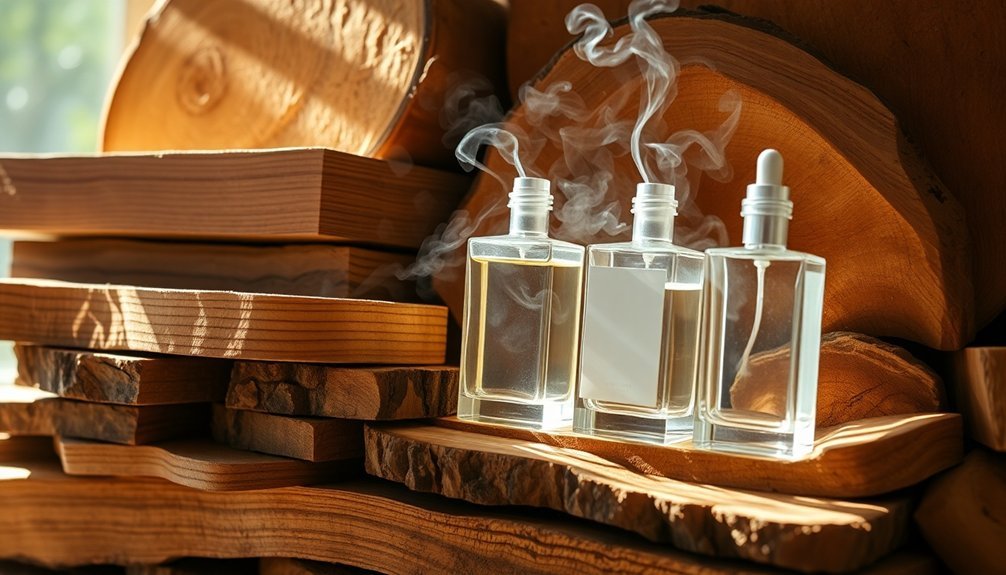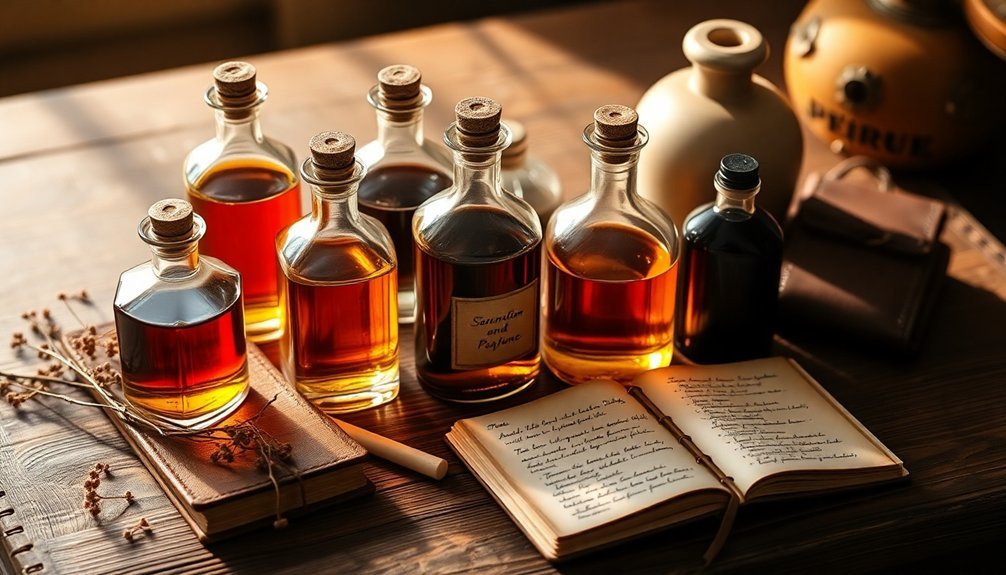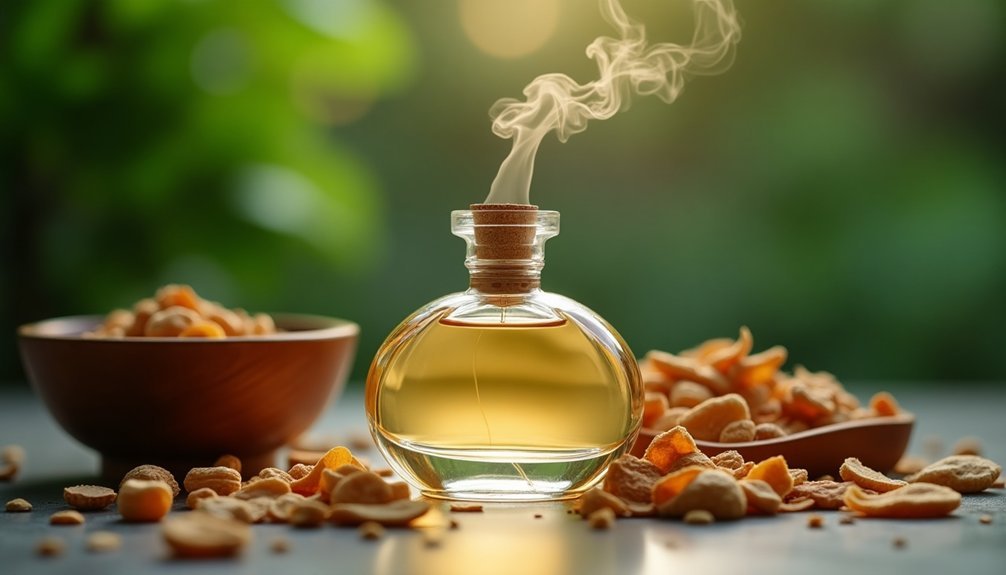To master woody notes in perfumery, you'll need to understand four key categories: dry, mossy, resinous, and creamy woods. Start by combining these notes at proper ratios – typically 20% for base notes – while using essential tools like precision droppers and proper storage containers. Add complementary elements like citrus, florals, or oriental notes to create depth and complexity. Your journey into sophisticated wood-based fragrances is just beginning to unfold.
Understanding Common Woody Notes in Perfumery

While many fragrance families contribute to perfumery, woody notes form an essential foundation that gives perfumes their depth and staying power.
You'll find four distinct categories: dry woods, mossy woods, resinous woods, and creamy woods, each bringing unique characteristics to fragrances.
Dry woods like vetiver and cedarwood offer earthy elegance with smoky undertones, while mossy woods such as oakmoss and patchouli provide damp, rich sweetness.
If you're looking for balsamic sweetness with a touch of spice, you'll want to explore resinous woods like frankincense and myrrh.
For smooth, milky qualities, creamy woods – particularly sandalwood – are your go-to choice. These woody ingredients serve as base notes in perfumery, extending the longevity of fragrances.
Understanding these categories helps you appreciate how woody notes anchor perfumes and create sophisticated compositions that evolve beautifully over time.
Essential Tools for Blending Woody Fragrances
You'll need essential blending tools like precision droppers, pipettes, and small glass beakers to accurately measure and mix your woody fragrance components.
For proper storage of natural ingredients, invest in amber or cobalt glass bottles with airtight seals to protect your materials from light and oxidation.
Keep your workspace organized with labeled containers and a designated storage area maintained at a consistent temperature, away from direct sunlight and humidity. Chemical stability is crucial for preserving the quality and longevity of your fragrance materials over time.
Basic Blending Equipment Needed
Before diving into woody perfume creation, gathering the right equipment guarantees precise measurements and safe handling of fragrance materials.
You'll need a digital scale that measures to 0.01g, along with pipettes and graduated cylinders for precise liquid measurements.
For blending, you'll want glass stirring rods, magnetic stirrers, and offset spatulas to confirm thorough mixing.
Don't forget essential safety gear: protective gloves, safety glasses, and a lab coat to protect yourself while working with concentrated materials.
Store your creations in glass beakers and bottles, which maintain fragrance stability better than plastic.
Keep dropper bottles handy for working with small quantities, and use adhesive labels to track your different blends.
Remember to document your blending processes and results in a dedicated perfumer's notebook for future reference.
A well-ventilated workspace and nearby fire extinguisher are non-negotiable safety requirements.
Natural Ingredient Storage Solutions
Proper storage of natural fragrance ingredients forms the foundation of successful woody perfume creation. You'll need dark glass bottles with tight-fitting caps to protect your precious materials from light and oxidation. Transfer your oils to smaller containers to minimize headspace, which helps preserve their complex woody characteristics.
| Storage Element | Best Practice |
|---|---|
| Container Type | Dark glass bottles only |
| Environment | Cool, dry, away from sun |
| Organization | Label with name and date |
| Safety | Use protective gear, prevent spills |
Maintain a dedicated storage area that's well-ventilated and temperature-controlled. Don't store your ingredients near heat sources or in humid conditions. If you're using refrigeration, keep your fragrance materials separate from food items. Regular monitoring guarantees your woody notes remain potent and true to their original character, maximizing their potential in your perfume creations.
Base Note Ratios for Woody Perfumes

When crafting woody perfumes, you'll need to master the art of proportions, starting with a base note ratio of 20% in your total composition.
You can layer multiple woody notes like sandalwood and cedarwood, but keep their combined strength balanced within that 20% framework to avoid overwhelming the fragrance.
To achieve depth and sophistication, try splitting your woody base notes into primary and secondary roles – for instance, using sandalwood as your dominant base at 15% and adding a touch of vetiver at 5% for complexity.
Ideal Base Note Proportions
Understanding base note proportions is essential for creating well-balanced woody perfumes that last. While base notes typically make up just 5-10% of your blend, they're vital for achieving that deep, lasting character that defines woody fragrances.
When crafting your woody perfume, consider these proven ratios:
- Classic blend: 20-40% top notes, 50-75% middle notes, and 5-10% base notes
- Traditional 1:1:1 ratio for a balanced composition
- Dynamic 3:2:1 ratio for more complexity
- Bold 4:2:1 ratio for stronger top notes
You'll want to incorporate woody base notes like sandalwood, vetiver, or patchouli to establish that characteristic earthy foundation.
Remember to add these notes drop by drop, testing the blend as you go. Combining them with jojoba oil can enhance their staying power and create a more stable fragrance.
Balancing Strength Among Woods
Mastering the delicate balance of woody notes requires careful attention to each ingredient's potency and character.
You'll need to understand how different woods interact to create a harmonious blend that doesn't overwhelm the senses.
When combining multiple woody elements, start with a foundation of balanced ingredients like sandalwood, vetiver, and cedar wood.
You can soften strong woody notes by incorporating aromatic herbs such as lavender or rosemary.
For the best results, maintain a ratio of 30% top notes, 50% heart notes, and 20% base notes in your composition.
To achieve ideal balance, dilute most materials to 10% concentration, except for potent ingredients like ambroxan.
Remember that even small amounts of powerful woods like oud can dominate your blend, so use them sparingly and adjust as needed.
Layering Multiple Woody Notes
The art of layering multiple woody notes demands precision in both selection and proportion.
You'll want to keep your base notes at 20-30% of your total perfume composition to guarantee proper longevity and stability. For a 20ml perfume, this means using about 0.4ml of base notes within your 2ml essential oil blend.
When working with multiple woody notes, consider these key factors:
- Adjust ratios based on the specific woods you're using, as some are more potent than others
- Balance each woody note against complementary ingredients like citrus, floral, or amber
- Consider your body chemistry, as it affects how each wood note develops
- Test different combinations until you find the perfect harmony between your chosen woods
Complementary Notes That Enhance Wood Accords
When creating alluring wood-based fragrances, perfumers rely on strategic combinations with complementary notes to enhance their compositions.
You'll find citrus notes like bergamot and neroli adding invigorating freshness, while florals such as jasmine and rose intertwine to create romantic depth.
Oriental elements, including amber and spices, merge beautifully with woods to produce mysterious, sensual blends.
Additional enhancers can transform woody fragrances into complex masterpieces.
Vanilla brings creamy sweetness, while tonka bean adds warm undertones.
Leather notes introduce smoky nuances, and fougère accords featuring lavender create seasonless appeal.
You can see these combinations at work in iconic fragrances like Terre d'Hermès, which pairs vetiver and cedarwood with orange, or Tom Ford's Oud Wood, which masterfully blends multiple woody notes with oriental spices.
Creating Depth With Layered Wood Elements

Building remarkable depth in woody fragrances requires strategic layering of different wood elements.
You'll find that combining various wood types creates complex, sophisticated scents that evolve throughout the day. Start with dry woods like cedarwood or vetiver as your foundation, then add creamy sandalwood for warmth and richness.
Layer in mossy woods for earthiness, and finish with resinous elements for an exotic touch.
- Pair dry woods with citrus top notes to create lasting freshness while maintaining sophistication
- Add creamy sandalwood to floral blends for a smooth, elegant base that doesn't overpower
- Combine mossy woods with oriental notes to achieve deep, mysterious undertones
- Layer resinous woods with spices and amber for a luxurious, exotic finish
These combinations will help you craft fragrances with impressive depth and character.
Testing Methods for Woody Blends
Properly testing woody blends guarantees you'll create balanced, market-ready fragrances that perform consistently across different conditions.
Start by evaluating your blend using clean smelling strips – dip, wave, and gently sniff to assess the initial notes without overwhelming your senses.
Next, create small wax melts to understand how your woody fragrance behaves when mixed with wax. Pour a 6-10% concentration into melted wax and observe the scent throw.
Test the blend on your skin to experience its evolution and dry-down over several hours.
Finally, evaluate your creation in various environments, comparing it with market benchmarks.
Don't forget to maintain a testing journal and gather feedback from trusted testers.
These systematic methods will help you perfect your woody blend before launch.
Balancing Strength and Longevity

Creating a well-balanced woody fragrance requires careful attention to both its strength and staying power.
You'll want to focus on combining the right concentration of oils with complementary notes that enhance longevity. Woody base notes naturally last longer due to their heavier molecules, but you can amplify their effectiveness through strategic blending.
- Use a higher concentration of perfume oils (15-20%) to guarantee your woody blend maintains its presence throughout the day.
- Combine woody notes with other long-lasting elements like amber, musk, or vanilla to create a solid foundation.
- Layer your fragrance by applying an unscented moisturizer before the perfume to lock in molecules.
- Store your woody blends in a cool, dark place to preserve their potency and prevent degradation.
Troubleshooting Common Wood Note Issues
When working with woody notes in perfumery, you'll likely encounter several common challenges that can affect your final composition. You'll need to navigate the authenticity gap between synthetic and natural woods, especially when your audience is familiar with real wood scents. Watch for overused notes like cedar and sandalwood that might make your creation feel too familiar.
| Challenge | Solution |
|---|---|
| Synthetic feels artificial | Blend with natural woods like Atlas cedar |
| Smoky notes too strong | Balance with lighter, earthy vetiver |
| Limited wood variety | Explore uncommon woods like sycamore |
| Poor longevity | Add amber woods as fixatives |
| Lack of depth | Layer wet, dry, and mossy woods |
To troubleshoot effectively, consider combining different wood types and exploring lesser-known options. You'll find that proper structuring and strategic layering can transform common issues into opportunities for unique expressions.
Storing and Aging Woody Perfume Blends

Beyond mastering woody notes, successful perfumers understand the art of storing and aging their creations. Your woody perfumes will benefit from proper storage and aging, particularly as base notes like sandalwood, oud, and cedarwood become richer over time.
During the essential maceration period of 2-4 weeks, you'll want to protect your blends from environmental factors that can degrade their quality.
- Store perfumes in cool, dark places away from bathrooms, using amber or dark glass bottles for protection
- Allow alcohol-based woody blends to macerate for at least 2-4 weeks before use
- Monitor temperature fluctuations, as heat can cause top notes to evaporate prematurely
- Keep bottles sealed to minimize air contact and preserve the integrity of the woody base notes
The aging process integrates your composition's elements, creating a more sophisticated and cohesive fragrance profile.
Frequently Asked Questions
Can I Use Synthetic Wood Notes Instead of Natural Ones?
Yes, you can definitely use synthetic wood notes. They're more cost-effective and consistent than natural ones, plus they offer excellent longevity. However, you'll sacrifice some of the depth and complexity natural notes provide.
How Do Temperature Changes Affect Woody Perfume Blends During Storage?
You'll need to store your woody perfumes between 60-70°F to protect their rich notes. High heat can break down essential compounds, while proper cooling helps preserve their depth and prevents unwanted changes in scent profile.
What Causes Woody Notes to Smell Medicinal in Some Blends?
You'll notice woody notes smell medicinal when they're too concentrated, mixed with certain herbs, or if using lower quality ingredients. Poor blending with resins and spices can also create unwanted medicinal undertones.
Are Certain Woody Notes More Suitable for Masculine or Feminine Perfumes?
You'll find that while any woody note can work in masculine or feminine fragrances, cedarwood and pine tend to lean masculine, while creamy sandalwood and soft patchouli are often preferred for feminine scents.
How Long Should Woody Perfumes Mature Before Their Final Assessment?
You'll want to let woody perfumes mature for 2-3 months minimum, as their complex resins need time to integrate fully. For richer, deeper scents, you can extend maturation up to 6-12 months.
In Summary
You've now mastered the fundamentals of working with woody notes in perfumery. Take your time experimenting with different ratios and combinations, and don't forget to document your successful blends. Remember that patience is key when balancing these complex materials. Trust your nose, keep testing your creations, and you'll develop the confidence to create sophisticated woody perfumes that stand the test of time.





Leave a Reply